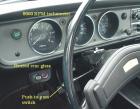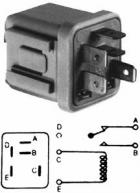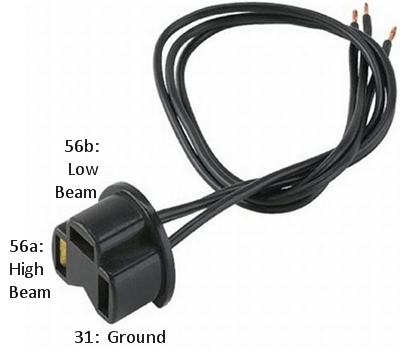Datsun B110 headlights are fused through the fuse box. No relays are used. Original Specs for headlights are 50/40 watt (standard large round headlights). From the fuse box "Battery" side (always hot, not dependent on ignition key position), through a 15-amp fuse the circuit goes to the Light Switch. From the Light Switch it goes to the Dimmer switch on the column. From here -- depending on the position of the Dimmer lever position -- it goes to either the low (DIM) beam of the headlights or the high (MAIN) beam of the headlights.
Also see: Headlight Specifications
Contents |
Overview
The headlights are grounded via the main wiring harness.
Completing the headlight features is the "High Beam" light in the instrument panel. This is connected to the high-beam circuit to light up a visual indicator on the dash when the high beams are on.
So the headlight circuit has these components:
- Two identical headlights
- (Standard 12V "large round" type used by all makes of older vehicles)
- 15A Fuse in fuse box
- Light Switch
- Dimmer switch (T/S & Light Switch on steering column)
- High-beam indicator lamp in instrument panel
- Wiring and connectors
- Relays are NOT used
Earthing
The headlights are grounded via the main wiring harness.
Light Switch
Australia
light switch - Australia

With the knob pushed in, no circuits are connected.
With knob pulled out to Position one (POSH) you are simply smashing
With knob pulled out to Position two (POLL) you are just common
With knob TWISTED, the dash lights are bright or dim
USA
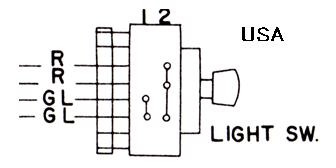
With the knob pushed in, no circuits are connected.
With knob pulled out to Position one, the parking lamps are activated
With knob pulled out to Position two, parking + headlights are activated
| OFF | no connections |
| Pull stop 1 (halfway out) |
|
| Pull stop 2 (all the way out) |
|
| R | Headlight hot feed Input
|
| R | Headlight circuit hot Output
|
| n/a | no connection |
| n/a | no connection |
| GL | parking lights hot feed
|
| GL | parking lights circuit output
|
Low/High Beam Circuit
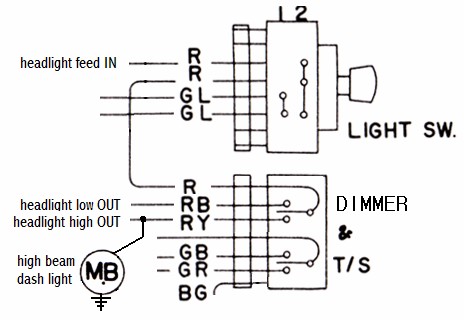
With the T/S lever pulled back, power goes to Low beams
With the T/S lever pushed forward, power goes to High beams
| RY | Headlight hot feed |
|
| RB | headlight low-beam |
|
| RW | headlight high-beam |
|
Headlight Socket
Headlight socket| B | Ground | body connection |
| RW | (high beam) to one RW terminal of Dimmer Switch | only powered if Dimmer lever is forward |
| RB | (low beam) to RB terminal of Dimmer switch | only powered if Dimmer lever is back |
Passing Light Switch
A passing light feature was an option for B110. If your turn-signal lever has a push-button on the end, it's the passing light switch. Push it in, and the headlights light while it's pushed in (regardless of whether lights are on or off).
This is composed of two parts:
- The switch itself is part of the turn signal (on the steering column).
- The relay. 1200s don't use headlight relays, except for this optional Passing Switch. It looks very much like the Horn Relay.
Note that this just wires in series with the standard wiring. From the 'L' fuse to the high-beam wiring, the switch bypasses simply the regular switch, firing the Main Beams.
- The red circle indicates the part of the T/S switch that is different from a normal T/S switch
Relay
Datsun 1200 doesn't use a headlight relay. But a more serious peformance issue is that the main wiring goes through a 20-gauge Fusible Link. Headlights want a 14 gauge wire -- much larger than 20 gauge -- for the full voltage to reach the lights. If using high-power H4 lights, you might even go with yet even larger 12 gauge wire. There is no need to go any larger.
Most cars use a headlight relay, to keep high power from going through the headlight and dimmer switches. You may add a relay to the Datsun 1200 to improve the power to the headlights. Some club members report the headlights are much brighter when wired up this way.
You can get 14-gauge connectors and wires, the fuses and lengths of wire from a wrecking yard. Or buy the parts new, which is easier.
Harness Kit
If you have more money than time, a Relay wiring kit is really easy:
Take the new harness:
- Connect HOT wire
- Ground/earth the relays
- Plug into existing headlight connector
- Plug harness into headlights
- Comes with the proper fuses and will bypass the stock Fusible Link
Your'e Done! Only $129 USD Painless Wiring Headlight Harness with relays
DIY
Do it yourself. I recommend 14-gauge for Halogen, but you can use 12-gauge for H4 high-power headlights.
- 14-gauge wire for the HOT side (RED or whatever color you want)
- 14-gauge wire BLACK for the earth/ground side
- Headlight connectors with 14-gauge leads
- Two fuses (or circuit breakers?) 10 amp each (20 amp for H4):
- 10 amp is up to 100W per side (up to 200W total)
- Halogen extra brights are 65W each (original spec is 50W)
- Two relays of 20A rating, get a reliable OEM unit like this common Nissan part:
- Connect two short lengths of red wires to the BAT + or ALT + (your choice)
- Fix fuses to these two short HOT wires, to protect the rest of the new wiring
- Then more HOT to the Relays (D). Keep the wires as short as is feasible
- more HOT wire from relays to the headlight connectors
- High-beam relay (B) to the new headlight connector 56a High-beam
- Low-beam relay (B) to the new headlight connector 56b Low-beam
- Fix BLACK from new headlight connectors to a body ground or engine block
- Fix BLACK from Battery cable terminal to body ground (not needed if your Battery cable is already 12-gauge)
- connect small wires (20 gauge is fine) from one of the original headlight connectors to relays. Just leave the other connector alone.
- One wire from 56b to the low-beam relay switch trigger (C)
- another wire from 56a to the high-beam relay switch trigger (C)
- connect small black wire to ground both relays switch (E)
- can ground it:
- to body, or
- to engine block, or
- or to 31 of original headlight connector
- can ground it:
- To prevent corrosion, seal all the wire connection ends with a sealer

![[Datsun 1200 encyclopedia]](/wiki/upload/wiki.png)
